Christmas closure: The Archive will be closed from 15 December to 2 January
Today, one in three women wears an M&S bra.
In fact, we’ve been selling lingerie for over 90 years!
This exhibition explores the world of M&S lingerie, from bras and knickers to girdles and corselettes. We’ll look at garments from the archive collection, as well as marketing and advertising material, staff training guides and film.
The 1920s saw an increase in consumerism, the spending power of working people increased, and the cost of living was falling.
Many women could now afford to buy ready-made garments, rather than making everything themselves.
In 1926 we opened our drapery department, which included lingerie as well as clothing for adults and children.
Staff bulletins from 1927 give us an insight into popular products at the time, which included fleecy knickers, free-run bodices, cami-bockers (knee-length knickers with poppers that attached to a camisole), and elastic garters – reported as ‘an exceptionally fast seller at Christmas’.
We were still selling haberdashery for customers who wanted to make their own. Store managers were advised on how to increase sales of elastic – fancy garter elastic and artificial silk elastic were sold by the yard.
The earliest bra in our collection dates to the late 1920s.
The cups are made of artificial silk, or rayon. The front panel is a double-layered cotton and elastic, much more flexible than earlier bras or corsets. It’s supportive yet retains the flatter, more boyish silhouette popular at the time.
Stockings were a best seller. Slightly shorter dress styles meant emphasis was placed on legs, ‘your underwear was suddenly outerwear, visible to all’ Lou Taylor, Through the Looking Glass, 1989.
In 1928 customers could buy artificial silk stockings in shades including ‘gunmetal’, ‘Paris’ and ‘Florence Mills’ – named after a popular American jazz singer.
1930s window displays show how these ranges were promoted, lingerie certainly wasn’t hidden away. Sales assistants made imaginative, creative displays with the products to entice customers inside.
By 1932 our lingerie range had expanded to suit different body shapes.
We sold uplift bras that guaranteed a ‘perfect figure’, and hook-sided girdles giving ‘that slim silhouette demanded by present fashions’ The Marks & Spencer Magazine, Christmas 1932.
1930s customers selected a bra by chest size, not cup size. Women adjusted their new bras at home, we have several in the collection that have been altered with tiny stitches at the straps and cups.
Stock control documents show that by 1939 we were selling at least 30 styles of bras – mostly available in white or peach, sometimes blue.
Styles included rubber ‘Reducing Brassieres’ and an Outsize range. We also sold a range of sanitary belts and towels.
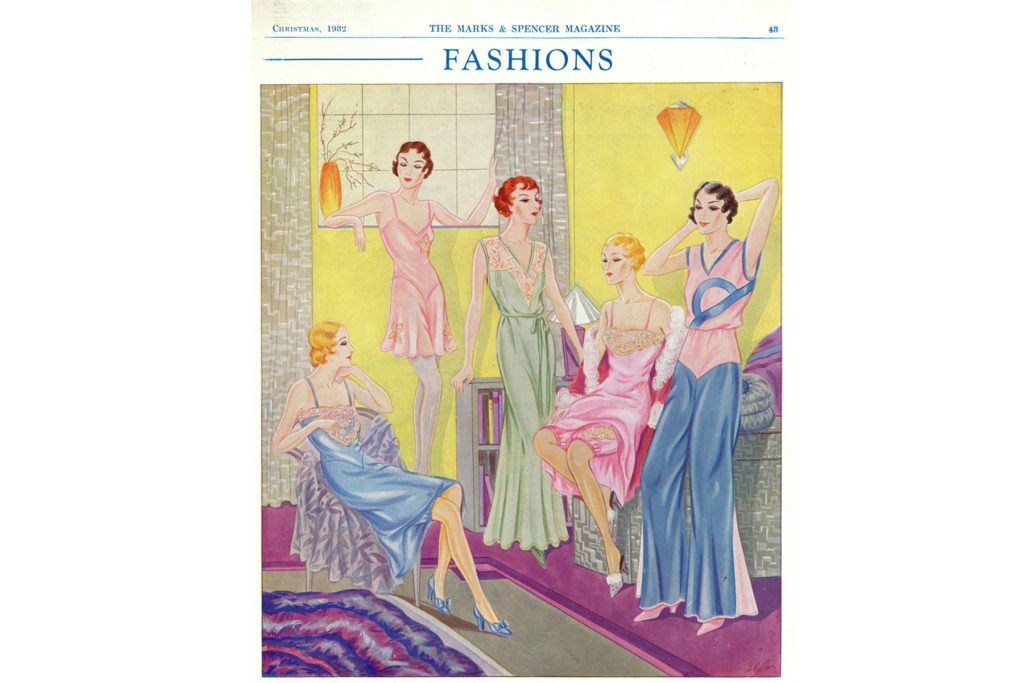

Pyjama suits had been popularised in the 1920s by designers such as Chanel and Vionnet, and by the 1930s they were even being worn outside the bedroom.
In 1931, Vogue magazine declared, ‘A woman may wear pyjamas to quite formal dinners in her own house, to other people’s dinners in town and country if you know them well and the more iconoclastic members of the female sex even wear them to the theatre’ Vogue, June 1931.
Artificial silk, or rayon, was a synthetic fibre developed in the late 1890s, made with cellulose from wood pulp. It was popular for lingerie as a more affordable alternative to silk, and a more luxurious option than cotton or wool.
During the Second World War Head Office teams were moved out of London to ensure day to day business wasn’t interrupted by air raids and transport problems.
Both the Corsetry and Woven Underwear Buying departments were relocated to Leicester.
Wartime restrictions, austerity measures and the Utility Scheme meant designers had to work harder to make attractive yet practical garments. Despite this, we were still able to produce glamorous lingerie using artificial silk.
We’ve always helped our customers find the perfect fit.
Before fitting rooms were introduced, sales assistants were trained to measure customers on the shop floor.
In the late 1940s we developed our bra sizing to include three cup sizes – small, medium and large. This meant our bras fitted a much wider range of customers, though some customers would still make final adjustments at home.
In 1947 we tried a new way of selling lingerie. At a trial store special inward-facing counters were arranged to create a more private space where customers could discuss their ‘corseting problems’.
Takings went up because, although each transaction took longer, customers were more willing to ask for the service and advice they needed. Exchanges decreased as customers bought the correct size first time around.


Interest in lingerie increased in the 1950s.
The prevailing style, nipped in waists and full skirts influenced by Christian Dior’s New Look, required the support and underpinning that only lingerie could provide.
Our Corsetry department used new display techniques, which increased sales. In 1953 over a fifth of all bras bought in Britain were from M&S, and in the run up to Christmas 1956, our Leeds store sold 660 pairs of knickers in just over two hours.
By 1953 we offered a range of support garments, from suspender belts and roll-on girdles to hook-sided girdles and fully laced corsets.
Sales assistants were provided with product information. For example, suspender belts were ‘mainly for the teenager’; roll-ons gave gentle support, apparently with complete freedom of movement; while laced corsets were for those who needed ‘strong support to back and abdomen’ Staff Management News, June 1953.
Our stockings were originally sized using leg measurements from American women and foot sizes of Dutch women, so not necessarily accurate for British women!
In 1956 we conducted a survey, measuring the legs of 600 M&S sales assistants. 17 measurements from each leg and information like the subject’s age and what type of work she did were recorded.
M&S first sold tights in 1963, available in various shades including the popular American Tan. By the end of the 1960s tights were outselling stockings.
Joan and Patricia of the Research department gathered all the data for our stocking survey, visiting stores across the UK to take measurements.
The survey gave our hosiery teams a much better idea of how customers’ legs were shaped, resulting in a new range of super-fit fully fashioned stockings.



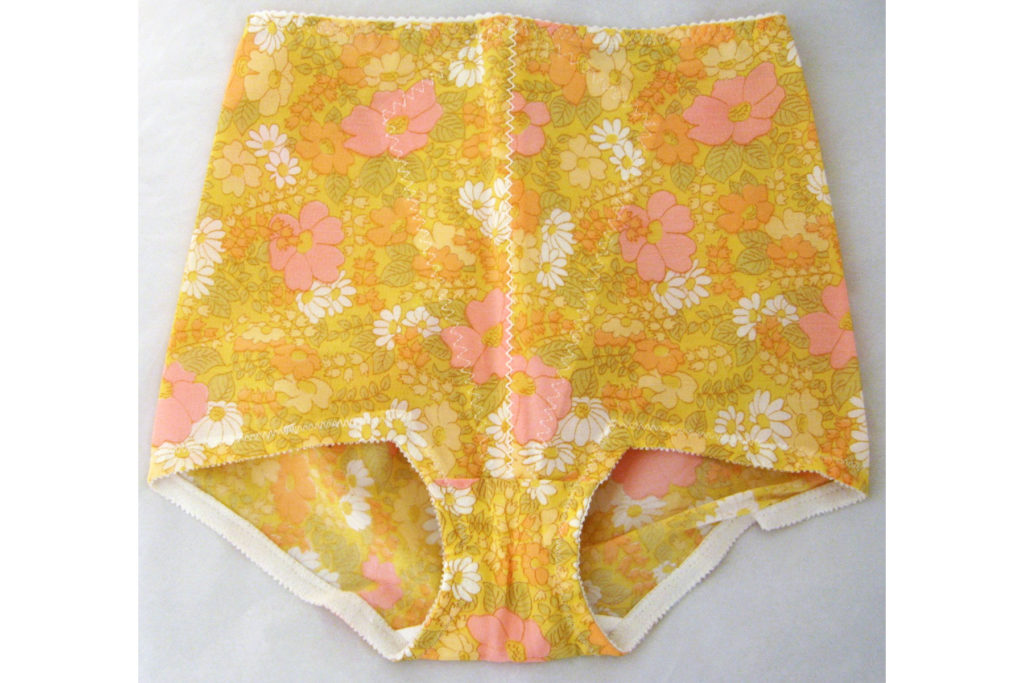
In 1957 we trialed full-body shaping lingerie.
Girdles and corselettes were promoted as we encouraged customers to buy supporting garments.
In 1961 we introduced the first tailored slip, a revolutionary product invented to be worn under pencil skirts and the slimmer fitting dresses of the time. A technical approach was taken – M&S engineering services were even drafted in to ensure the slip took the strain, not the skirt.
In 1965 we were the first retailer to sell matching bras, girdles and panty girdles on a large scale. The range was aimed at younger customers – both in design and price, each bra cost 9s/11d.
We said, ‘American women have been wearing panty girdles for years, but it has taken a mini-skirt revolution and the consequent use of tights for the British girl to start blessing the designer who introduced the gusset into girdles’ St Michael News, Feb 1968.
Our designers noticed that all-in-one bra-slips were popular in Paris, and so brought the idea home in 1966.
The M&S bra slip became a best seller due to its practicality in combining two separate garments, plus its shorter length suited mini-skirt fashions.
In 1969 we adopted international bra cup sizes A, B, C and D, replacing small/medium/large sizes. Lettered sizes had been used since the 1930s in America, and were phased in across the UK from 1969.
A 1969 staff newsletter reported that one of the first people to purchase a new size bra was actress Diana Dors, during a trip to M&S. In a very 1960s way the magazine also noted Ms Dors’ bra size!
Our cinema adverts of the late 1950s and early 1960s promoted new synthetic fabrics. Stores would have promotions on the featured products so viewers could go straight out and buy them.
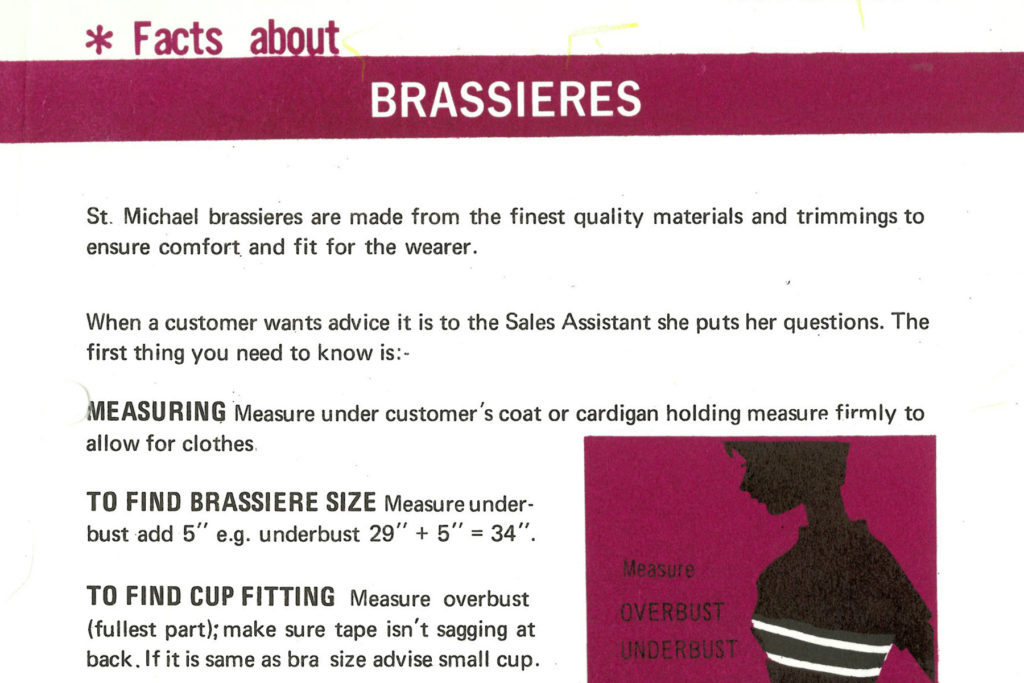
In the 1970s we saw a more natural shape emerge in both bras and knickers, with little or no support.
In 1971 we introduced a lace, unlined bra – 18 months later we’d sold a million! It became the best-selling bra in Britain in 1972.
We also exported lingerie. There were St Michael concessions in chain stores, St Michael shops, and standalone M&S stores in various locations. By 1977 knickers were our largest export – nearly 4 million pairs a year were sold around the world.
Measuring techniques for lingerie hadn’t really changed by the 1970s. Changing rooms were only introduced towards the end of the decade, so staff continued to measure bra size on the shop floor under customers’ coats.
A 1983 campaign, Bras for Today’s Woman, encouraged customers to buy a wardrobe of different bras.
We said, ‘Ladies need at least three styles: a good, softly shaped day bra, a seamless bra for the ‘natural’ look to wear under t-shirts and a deeply plunging glamour bra for evenings’ St Michael News, Feb 1981.
In 1984 we launched a sports-inspired underwear range. Again, influence came from America, where apparently ‘sporty undies are all the rage’ St Michael News, May 1984.
By the mid-1980s we were selling bras specifically intended for sports, and by 1992 sales assistants were trained in advising customers which bras were most suitable for exercise.
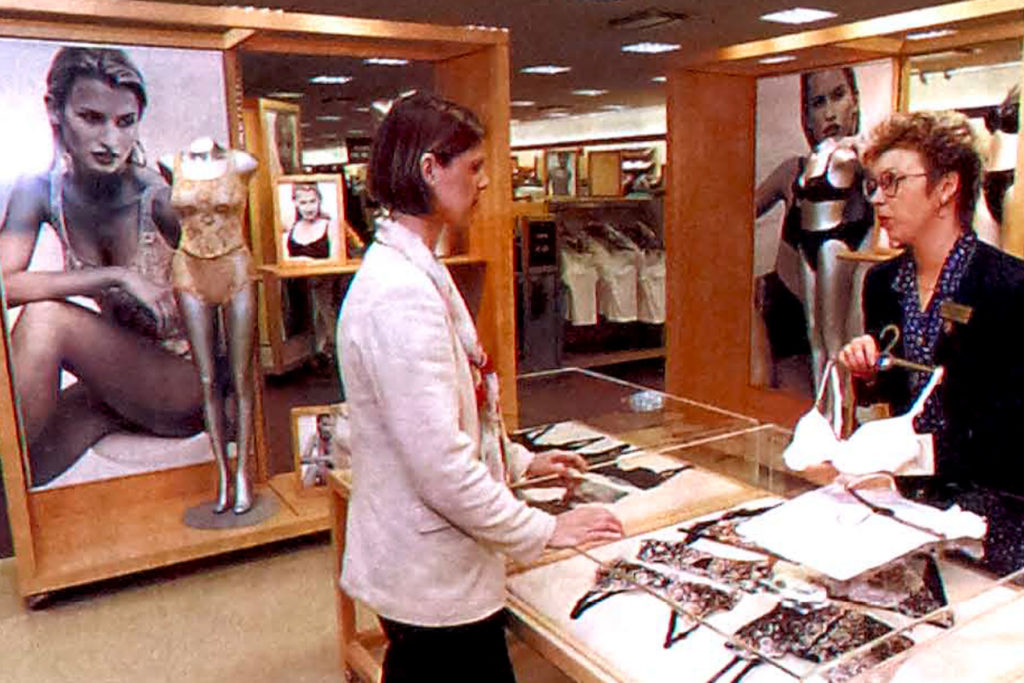


In 1997 we made our lingerie departments and products more appealing, including the launch of a new bra fitting service.
M&S researchers visited eight countries in 10 weeks, buying lingerie and looking at the retail environment. We acted on the findings, creating welcoming, easier to shop spaces.
Post-surgery bras were introduced at the start of the 2000s. Designed with women who had had partial or full mastectomies, a new range in 2006 included more colour and detailing than before.
In 1994 we began selling lingerie for a wider range of customers. We surveyed 500 brides before creating a range of bridal lingerie, introduced plus size lingerie, and our first maternity range – designed in consultation with midwives, health visitors and the National Childbirth Trust.
We’ve often collaborated with guest lingerie designers.
In 1999 the Salon Rose range from Agent Provocateur arrived in store, including bridal and maternity collections.
Model and actor Rosie Huntington-Whiteley launched her first range of M&S lingerie in 2012. The collaboration continues today, including swimwear, loungewear and sportswear. Since 2012 the Rosie collection has broken sales records.
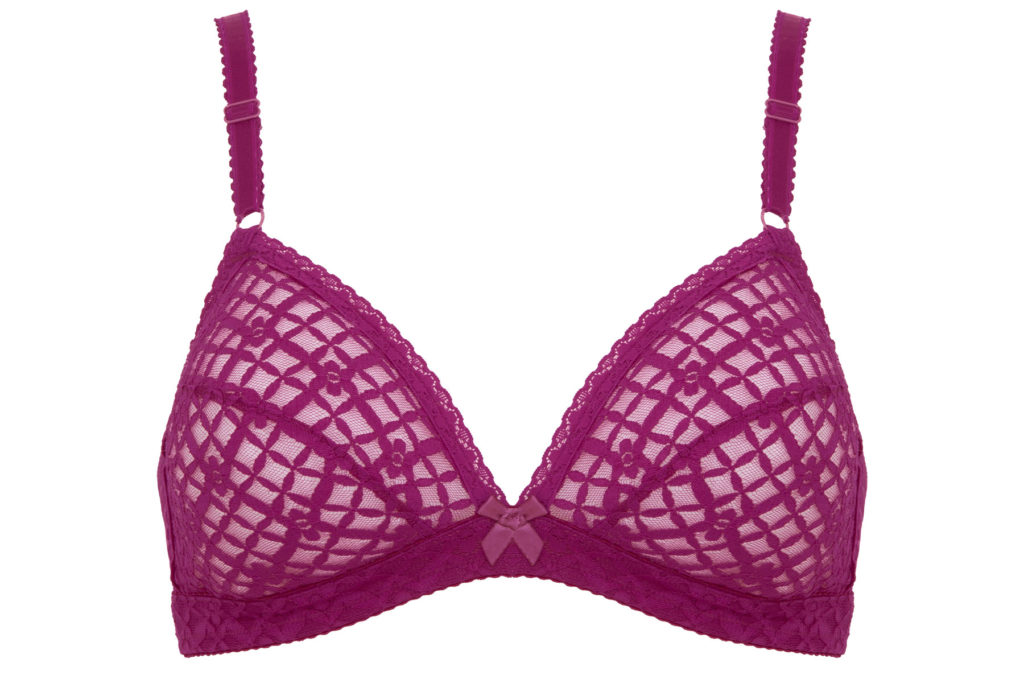
The archive continues to be an inspiring resource for colleagues in our design departments.
In 2016, when we celebrated 90 years of lingerie, designers visited the archive to view our lingerie collection.
They chose the best-selling 1970s lace bra to redesign for 2016. The new bra was available in three colours, underwired and non-wired with matching knickers.
We’ve found new ways to help customers find the best fit. During the Covid-19 pandemic in 2020 we gave customers the resources they needed to measure themselves for a new bra, and at the start of 2021 we began offering virtual bra-fits, where customers can chat to a bra fit expert from the comfort of their own home.
Recent additions to our lingerie ranges include period underwear, providing an alternative to disposable period products, and sleep bras that give gentle support through the night.